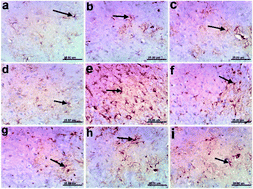Retracted Article: The anti-Alzheimer potential of Tamarindus indica: an in vivo investigation supported by in vitro and in silico approaches†
Abstract
Tamarindus indica Linn. (Tamarind, F. Fabaceae) is one of the most widely consumed fruits in the world. A crude extract and different fractions of T. indica (using n-hexane, dichloromethane, ethyl acetate, and n-butanol) were evaluated in vitro with respect to their DPPH scavenging and AchE inhibition activities. The results showed that the dichloromethane and ethyl acetate fractions showed the highest antioxidant activities, with 84.78 and 86.96% DPPH scavenging at 0.10 μg mL−1. The n-hexane, dichloromethane, and ethyl acetate fractions inhibited AchE activity in a dose-dependent manner, and the n-hexane fraction showed the highest inhibition at 20 μg mL−1. The results were confirmed by using n-hexane, dichloromethane, and ethyl acetate fractions in vivo to regress the neurodegenerative features of Alzheimer's dementia in an aluminum-intoxicated rat model. Phytochemical investigations of those three fractions afforded two new diphenyl ether derivative compounds 1–2, along with five known ones (3–7). The structures of the isolated compounds were confirmed via 1D and 2D NMR and HRESIMS analyses. The isolated compounds were subjected to extensive in silico-based investigations to putatively highlight the most probable compounds responsible for the anti-Alzheimer activity of T. indica. Inverse docking studies followed by molecular dynamics simulation (MDS) and binding free energy (ΔG) investigations suggested that both compounds 1 and 2 could be promising AchE inhibitors. The results presented in this study may provide potential dietary supplements for the management of Alzheimer's disease.



 Please wait while we load your content...
Please wait while we load your content...